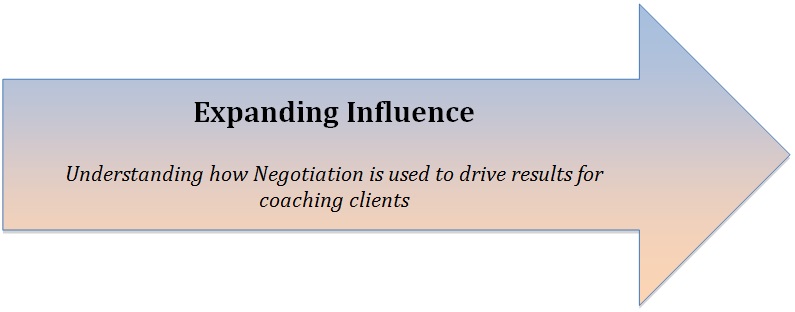
Research Paper By Susie Tomenchok
(Business Coaching, UNITED STATES)
 As coaches, we have to help our clients find an approach which will work for them to resolve or work through a solution. We need to listen and direct as we gather the cues from the client as we don’t walk in their shoes but we need to help them develop approaches that are comfortable for them and will gain the results that they are looking to attain. One of these areas we will approach with our clients is negotiation – how they will see it and how to embrace for maximum benefits.
As coaches, we have to help our clients find an approach which will work for them to resolve or work through a solution. We need to listen and direct as we gather the cues from the client as we don’t walk in their shoes but we need to help them develop approaches that are comfortable for them and will gain the results that they are looking to attain. One of these areas we will approach with our clients is negotiation – how they will see it and how to embrace for maximum benefits.
 We negotiate anytime we are interacting with another person (or ourselves) to get to a different place. It can be about the movie we are going to see with our partner, the nap time for our two year old or even regarding the morning workout we no longer want to participate in when we hear the alarm at 5am. As coaches, our clients will approach any and all of these situations and of course they may need our help in handling a formal negotiation for a new job, as a part of a transition package or with a peer in a corporate environment that is fighting with political vigor. Understanding negotiation can help us in providing context for our clients when they face any type of negotiation situation either formal or informal.
We negotiate anytime we are interacting with another person (or ourselves) to get to a different place. It can be about the movie we are going to see with our partner, the nap time for our two year old or even regarding the morning workout we no longer want to participate in when we hear the alarm at 5am. As coaches, our clients will approach any and all of these situations and of course they may need our help in handling a formal negotiation for a new job, as a part of a transition package or with a peer in a corporate environment that is fighting with political vigor. Understanding negotiation can help us in providing context for our clients when they face any type of negotiation situation either formal or informal.
In the next few pages, we will investigate several areas of negotiation. Using negotiation can lead to a stronger influence for our clients, which is an essential part of professional success. Negotiation attributes are important to explore as a coach as thinking about your practice and the ways to direct a client toward solid and positive results.
As we negotiate throughout our lives it is about being consistent, aware and making decisions based on what is best for the business without an alternative agenda. A person with strong negotiation skills will build influence that can be more powerful than a person with positional power. Negotiation should be considered a tool to help you navigate toward increased influence.
Lots of people get a knot in their stomach when they hear the word negotiation. Many people consider an interaction negatively if negotiation is happening. The truth is that negotiation happens all of the time and happens in almost every interaction.
Let’s look at negotiation in general and explore the context for our clients.
 Well first we need to understand that negotiation is not always a negative interaction. Basic negotiation is about asking questions and building relationships. You may negotiate a business deal or a new job but do you think about the other ways you negotiate every day.
Well first we need to understand that negotiation is not always a negative interaction. Basic negotiation is about asking questions and building relationships. You may negotiate a business deal or a new job but do you think about the other ways you negotiate every day.
The examples are end-less….
The art of negotiation is extensive full of strategies and tactics. It is essential to recognize that negotiation happens everywhere so we should embrace instead of running with fear! Building a negotiation tool belt builds influence and using negotiation can help a person plan, execute and maintain the level that is most useful for growth and success in anything they do.
The parts of negotiation include:
All of these areas are discussed within the book, “Negotiate This”. It looks at every aspect of negotiation and provides examples to lead a person to build great and useful tools. No negotiation is the same so understanding the aspects of negotiation is important when helping a person who is facing any type.
In using negotiation to increase influence, there are steps to consider depending on each unique situation. Knowing and understanding that all negotiations are different helps in directing a client, there is not a fool-proof approach. Become versed in many areas of negotiation, the outside influences and what to look for and a coach will be equipped in addressing concerns for each unique client.
 The first step is to objectively understand your position in the company and where you need to improve or grow relationships in order to build allies to help you when you are pushing through an idea, project or initiative.
The first step is to objectively understand your position in the company and where you need to improve or grow relationships in order to build allies to help you when you are pushing through an idea, project or initiative.
You need to see the organization as intercepting with people in power positions based on titles, people who are doers and others who are influencers. The best way to illustrate it is to take the actual structure of the organization and then draw intersecting lines that show who is connected and how the lines of influence run.
When I worked for a telecommunications company, I was in charge of a sales group and I had a peer who also ran the other side of the sales force. Dean was a seasoned sales executive whose number one focus was commission structure for himself and his team. My agenda was to provide a consistent customer service because my team and myself were not compensated with commissions. Because my agenda was not for personal gain, I built a strong company wide reputation for action and I carried a high level of influence. I was given major projects and I could bring cross-functional teams together to execute the vision. Dean only participated when there was an opportunity to add a money-making customer or if a new project included a commission option. While Dean may have been able to satisfy his personal goals, his long-term ability to sustain his position was short-lived. Dean was let go when his agenda was illustrated through his actions and they saw he didn’t produce for the company’s gain first and foremost but for himself. This may seem like a drastic example but understanding Dean’s selfish agenda and its detrimental outcome, shows the importance of building influence.
When you understand the structure, the power people, the workers and the influencers, you have to build your plan. Like Dean, you cannot have an agenda that is self-serving because even with the strongest negotiators, you will not be successful in the long-term.

 Negotiating your way to influence begins with making the relationships that can create a positive alliance. The first step is establishing those relationships with the idea that your agenda is to further the business objectives of the organization. The first rule of negotiation is to ask – whether for something specific or for just to establish an alliance. Simply asking someone to engage is the way to build trust and as long as your agenda is not for personal gain, this will be another step in building a reputation of influence and effective leadership.
Negotiating your way to influence begins with making the relationships that can create a positive alliance. The first step is establishing those relationships with the idea that your agenda is to further the business objectives of the organization. The first rule of negotiation is to ask – whether for something specific or for just to establish an alliance. Simply asking someone to engage is the way to build trust and as long as your agenda is not for personal gain, this will be another step in building a reputation of influence and effective leadership.
So the initial connection and relationship negotiation is imperative but the focus should be what you can do for that person instead of what they will do for you. When you focus in that way, the person will trust your intentions. You should think this way genuinely though, it isn’t to get their trust and then change, and it is always to be mindful to help your network in any way possible. In sharing information, providing support, offering suggestions or giving insight in a way that is enlightening for the person. All is of value and shows that you respect and will be a strong and reliable partner. This person will naturally trust you and will speak of you in a positive way when you are unable to speak for yourself.
So building relationships one-on-one is powerful but it is important to build a strong relationship within “the crowd”. Building and negotiating your reputation is done in situations where you participate or lead others through projects or to further initiatives.
Consider these questions:
 Jordan was an executive who had a high level of influence cross-functionally in a huge organization. One of the contributing factors was her ability to run a cross-departmental meeting where she made sure the participants received value and support while making people accountable for their promises. She would build individual relationships to best understand individual’s goals. She also communicated effectively to ensure everyone was informed while running an effective meeting that communicated respect for everyone’s time. It was a community where people felt safe and learned to negotiate their needs to further the overall objectives of the company. After years, Jordan was promoted several times. When her final promotion occurred, she had to give up leading the meeting that brought all the teams together. That meeting unraveled within two months. Key players sent delegates, no one made people accountable and the effectiveness of the meeting became obsolete.
Jordan was an executive who had a high level of influence cross-functionally in a huge organization. One of the contributing factors was her ability to run a cross-departmental meeting where she made sure the participants received value and support while making people accountable for their promises. She would build individual relationships to best understand individual’s goals. She also communicated effectively to ensure everyone was informed while running an effective meeting that communicated respect for everyone’s time. It was a community where people felt safe and learned to negotiate their needs to further the overall objectives of the company. After years, Jordan was promoted several times. When her final promotion occurred, she had to give up leading the meeting that brought all the teams together. That meeting unraveled within two months. Key players sent delegates, no one made people accountable and the effectiveness of the meeting became obsolete.
Negotiation in public is about balancing the objectives, being a risk taker and asking people to step up. To gain influence, a person must take such risks.
Another area where an influencer focuses their negotiation is toward management. The negotiator needs to be clear about their goals ensuring these goals contribute to the overall business objectives.
When approaching management, be sure to check-off this homework:
Go to the meeting as a negotiator, clearly understand your objectives and anticipate their objections or questions. If you visualize the interaction, you will be more prepared to answer the questions they might need answered. Preparation is the most important attribute of a successful negotiator and everyone can use it in his or her day-to-day interactions. The other aspect of addressing management is to understand their focus and what keeps them up at night. You need to think strategically so that what you want can also benefit them in satisfying a need. What will it take to get them to say yes? Can they make the decision on their own or will they need to go to someone else to achieve approval? Knowing all of these interdependencies will make your pitch a success.
It is important to evaluate your influence to ensure you are building and sustaining a solid reputation so that your ideas and projects will move forward. It also helps to ensure management that will help you to be promoted when new opportunities are available sees you.
 Using negotiation strategies to increase and sustain your influence is paramount.
Using negotiation strategies to increase and sustain your influence is paramount.
Remember to :
 Using negotiation strategies to increase influence is a smart approach. Knowing these strategies and guiding a client will allow them to attain influence through negotiation for small situations or for the largest negotiation of their career.
Using negotiation strategies to increase influence is a smart approach. Knowing these strategies and guiding a client will allow them to attain influence through negotiation for small situations or for the largest negotiation of their career.
Negotiation is not a negative approach, in fact using negotiation strategies shows you are focused on the relationships and the importance of building strong, successful alliances.
Help to show your client to pay attention to the influence of others around them and how they may or may not use negotiation. They can learn many tools from these individuals as their successful tactics work within their unique organization.
Teach them to learn and introduce other ways to increase influence through negotiation and watch the results!!